一课一练答案
- 格式:pdf
- 大小:214.13 KB
- 文档页数:10
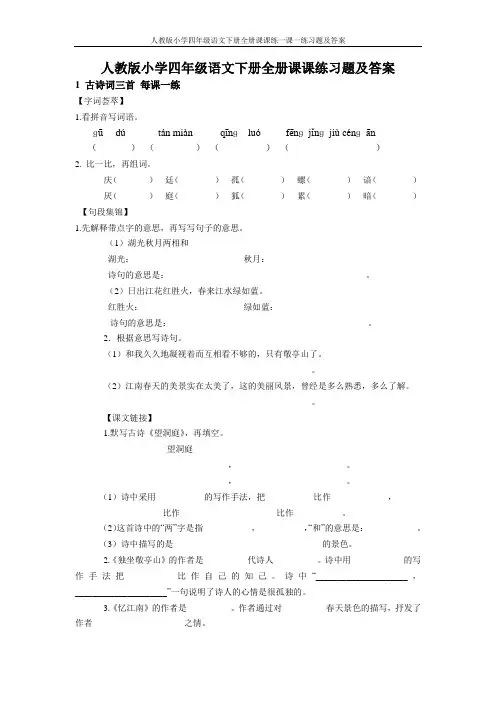
人教版小学四年级语文下册全册课课练习题及答案1 古诗词三首每课一练【字词荟萃】1.看拼音写词语。
ɡūdútán miàn qīnɡluófēnɡjǐnɡjiù cénɡān()()()()2. 比一比,再组词。
庆()廷()孤()螺()谙()厌()庭()狐()累()暗()【句段集锦】1.先解释带点字的意思,再写写句子的意思。
(1)湖光秋月两相和湖光:________________________ 秋月:________________________诗句的意思是:_____________________________________________。
(2)日出江花红胜火,春来江水绿如蓝。
红胜火:______________________ 绿如蓝:________________________诗句的意思是:_____________________________________________。
2.根据意思写诗句。
(1)和我久久地凝视着而互相看不够的,只有敬亭山了。
_____________________________________________。
(2)江南春天的美景实在太美了,这的美丽风景,曾经是多么熟悉,多么了解。
_____________________________________________。
【课文链接】1.默写古诗《望洞庭》,再填空。
望洞庭_________________________,________________________。
_________________________,________________________。
(1)诗中采用___________的写作手法,把___________比作_____________,___________比作______________________比作___________。
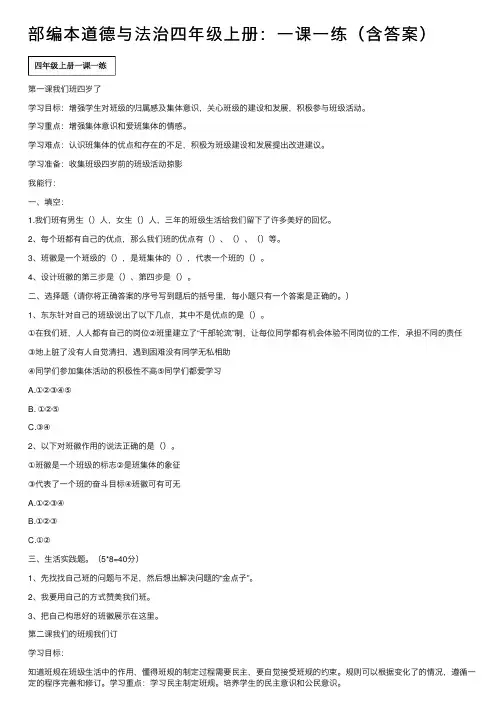
部编本道德与法治四年级上册:⼀课⼀练(含答案)第⼀课我们班四岁了学习⽬标:增强学⽣对班级的归属感及集体意识,关⼼班级的建设和发展,积极参与班级活动。
学习重点:增强集体意识和爱班集体的情感。
学习难点:认识班集体的优点和存在的不⾜,积极为班级建设和发展提出改进建议。
学习准备:收集班级四岁前的班级活动掠影我能⾏:⼀、填空:1.我们班有男⽣()⼈,⼥⽣()⼈,三年的班级⽣活给我们留下了许多美好的回忆。
2、每个班都有⾃⼰的优点,那么我们班的优点有()、()、()等。
3、班徽是⼀个班级的(),是班集体的(),代表⼀个班的()。
4、设计班徽的第三步是()、第四步是()。
⼆、选择题(请你将正确答案的序号写到题后的括号⾥,每⼩题只有⼀个答案是正确的。
)1、东东针对⾃⼰的班级说出了以下⼏点,其中不是优点的是()。
①在我们班,⼈⼈都有⾃⼰的岗位②班⾥建⽴了“⼲部轮流”制,让每位同学都有机会体验不同岗位的⼯作,承担不同的责任③地上脏了没有⼈⾃觉清扫,遇到困难没有同学⽆私相助④同学们参加集体活动的积极性不⾼⑤同学们都爱学习A.①②③④⑤B. ①②⑤C.③④2、以下对班徽作⽤的说法正确的是()。
①班徽是⼀个班级的标志②是班集体的象征③代表了⼀个班的奋⽃⽬标④班徽可有可⽆A.①②③④B.①②③C.①②三、⽣活实践题。
(5*8=40分)1、先找找⾃⼰班的问题与不⾜,然后想出解决问题的“⾦点⼦”。
2、我要⽤⾃⼰的⽅式赞美我们班。
3、把⾃⼰构思好的班徽展⽰在这⾥。
第⼆课我们的班规我们订学习⽬标:知道班规在班级⽣活中的作⽤,懂得班规的制定过程需要民主,要⾃觉接受班规的约束。
规则可以根据变化了的情况,遵循⼀定的程序完善和修订。
学习重点:学习民主制定班规。
培养学⽣的民主意识和公民意识。
学习难点:懂得班规应共同遵守,为保证班规执⾏,必须建⽴奖惩制度。
学习准备:查找以前的班规和执⾏情况。
我能⾏:⼀、填空题:1、没有规矩,不成,班规可以让我们。
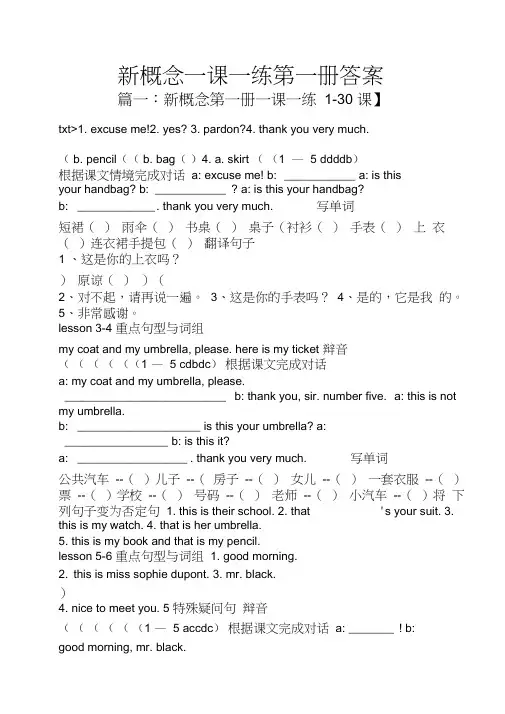
新概念一课一练第一册答案篇一:新概念第一册一课一练1-30 课】txt>1. excuse me!2. yes? 3. pardon?4. thank you very much.( b. pencil(( b. bag()4. a. skirt ((1 — 5 ddddb)根据课文情境完成对话a: excuse me! b: ___________ a: is thisyour handbag? b: ___________ ? a: is this your handbag?b: ____________ . thank you very much. 写单词短裙()雨伞()书桌()桌子(衬衫()手表()上衣()连衣裙手提包()翻译句子1 、这是你的上衣吗?)原谅())(2、对不起,请再说一遍。
3、这是你的手表吗?4、是的,它是我的。
5、非常感谢。
lesson 3-4 重点句型与词组my coat and my umbrella, please. here is my ticket 辩音((((((1 — 5 cdbdc)根据课文完成对话a: my coat and my umbrella, please._________________________ b: thank you, sir. number five. a: this is not my umbrella.b: ___________________ is this your umbrella? a:________________ b: is this it?a: _________________ . thank you very much. 写单词公共汽车--()儿子--(房子--()女儿--()一套衣服--()票--()学校--()号码--()老师--()小汽车--()将下列句子变为否定句 1. this is their school. 2. that 's your suit. 3. this is my watch. 4. that is her umbrella.5. this is my book and that is my pencil.lesson 5-6 重点句型与词组 1. good morning.2. this is miss sophie dupont.3. mr. black.)4. nice to meet you. 5 特殊疑问句辩音((((((1 — 5 accdc)根据课文完成对话a: _______ ! b:good morning, mr. black.a: ___________ . alice is a sophie is a new student. she isfrench. b: sophie, ________ hans. b: how do you do? a:________________ ?选择填空()1. --- ____________ ! are you mr. chen?---no, i am not. ---a. hello, goodb. sorry, excuse mec. hello, ok.d. excuse me,sorry. ()2. ---excuse me! --- ______ .---is this your handbag?--- no, it isn ' t.a. excuse me.b. pardonc. sorryd. yes ()3. --- how are you,miss wang?--- ___________ .a.. how are you, miss gaob. i ' m fine, thank you.c. you areright. i ' m fine.d. thank you.()4. good morning, mrs. read. _____________________ a. i ' m ok.b. i ' f m ine.c. thank you.d. good morning. ()5. ---how do you do? a. how are you? b. how old are you? c.how do you do?d. thank you very much. ()6. ---nice to meetyou. --- ____________ a. good morningb. hic. how do you do?d thank you very much. 写汉语russian--- _________ swedish--- ________ afternoon ---________ g erman--- _________ evening--- ________ a merican--student--- english --- french-- morning --- (1 — 6 dcbddd) 就划线部分提问【篇二:新概念英语一课一练】>lesson 1i. 根据所给汉语意思写出相应的英语单词或短语.1. 它 _______2. (女用)手提包_________3. 我(宾格)_____ 4. 是的___________5. 原谅___________6. 问题___________7. 感谢你ii. 根据所给的英语单词或短语写出相应的汉语意思1. pardon ________2. this ___________3. your4. whose _________5. very much ____________6. theniii. 完成下列对话.1. ______________ yes?2. __________ your bag? pardon?is this your bag? yes, 3. ______________ .thank you verymuch.iv. 把下列句子翻译成英语 .1. 对不起 ! ______________2. 这是你的手提包吗 ?3. 对不起 , 请您再说一遍 . _________4. 是的 ,这是我的包 .5. 非常感谢你 ! _________________________lesson 2i. 根据所给汉语意思写出相应的英语单词或短语 .1. _____________ 裙子 ________________2. 外套 ,上衣 ___3. 小汽车 _______________4.书 _______ 5. 钢笔 _________6. 手提包 _______7. 谁的 _________8. 手表 __________9. 房子 _______ 10. 衬衣 ___________ii. 根据所给首字母及汉语提示写出相应的英语单词 .1. is this your w _______ ( 手表 )?2. this isnt my p___ 笔 ).3. this is my s _____ ( 连衣裙 ).4. is this your s ________ ( 衬衣 )?5. this isnt my h __ 子).iii. 连词成句 .1. this , your , is, pen ( 一般疑问句 )___ ( 钢 ___ ( 房 2. is, this, not, dress, my3. pardon, i, beg, your4. very, thank, much, you5. this, my, pencil, yes, isiv. 把下列句子翻译成英语 .1. 这是你的上衣吗 ? ________________________________2. 是的 ,这是我的小汽车 . ______________________________3. 这是你的裙子吗 ? ___________________________________4. 不,这不是我的衬衣 .5. 这是我的书 .lesson 3i. 根据所给汉语意思写出相应的英语单词或短语.1. 伞__________2. 衣帽存放处_____________3. 请__________ 4. 票 ___________5. 这里_________6. 号码 ______________7. 外套ii. 根据所给的英语单词或短语写出相应的汉语意思1. my ___________2. five ____________3. sorry4. sir ______________5. word ____________6. youriii. 连词成句.1. ticket, here, my, is ___________________2. this, umbrella, your, is (一般疑问句)_____________________3. sir, am, i, sorry _______________________4. this, my, not,bag, is _____________________________________5. please, my, and, book, pen, myiv. 把下列句子翻译成英语.1. 这不是我的外套. ________________________2. 这是我(寄存东西)的牌子. ___________________3. 请把我的伞给我. _______________________________4. 非常感谢您, 先生. _____________________________5. 这是你的铅笔吗? _______________________________lesson 4i. 根据所给汉语意思写出相应的英语单词或短语.1. 儿子________2. 女儿_________3. 老师___________4. 学校 ____________5. 一套衣服______________6. 句子 ______________7. 连衣裙ii. 根据汉语意思补齐下列英语单词中所缺的字母.1. um__r__ll__ (伞)2. p__n__il (铅笔)3. t__ck__t (票)4. n__mb__r (号码)5. s__ __ rt (裙子)6. s__ __ rt (衬衣)iii. 完成下列对话.1. --- is this your coat? --- yes, __________2. --- is this your umbrella? --- no, ________________ .3. --- _________________________ ? --- yes, it is my dress.4. --- _________________________ ? --- no, it isnt my car.iv. 把下列句子翻译成英语.1. 这是你们的学校吗?___________________2. 这不是我的衬衣.____________________3. 这是你的手表吗?____________________4. 请回答这些问题.____________________5. 不,这不是我的房子.__________________lesson 5i. 根据所给汉语意思写出相应的英语单词或短语.1. 日本的,日本人____2.也_____3.德国的,德国人______4.遇见_____5.学生______6.早晨_____ii. 根据汉语意思补齐下列英语单词中所缺的字母.1. ch__n__s__ (中国的,中国人)2. n__w(新的)3. g__ __d (好的)4. f__ __ nch (法国的,法国人)5. south k__ r__an (韩国的, 韩国人)6. n__c__ (美好的)iii. 连词成句.1. miss sophie dupont, is, this ___________________2. meet,to, nice, you __________________________2. mr. blake, morning, good _________________________3. iis, hans, a , student, new __________________________4. chinese, lu ming, is ______________________________iv. 把下列句子翻译成英语.1. 这是索菲亚. 她是法国人.2. 布莱克是新来的老师.3. 很高兴见到你!4. 王华是中国人5. 早上好,汉斯.lesson 6i. 根据所给的英语单词写出相应的汉语意思.1. italian __________2. american _______________3.peugeot _______________4. mercedes __________5. make _______6. japanese___________ 7. german __________ii. 根据汉语意思补齐下列英语单词中所缺的字母.1. am__r__c__n (美国的)2. e__ __ l __ sh (英国的)3. s __ e _ ish (瑞典的)4. sp __n __ sh (西班牙的)5. f__ e__ch (法国的)6. south ko__ e__n (韩国的)iii. 用he, she, it, a , 或an 填空.1. this is naoko. _________ is japanese.2. this is ______ fiat.it is _______ italian car.3. its ______ mini. it is __________ english car.4. its_______ peugeot. it is _______ french car.5. sophie is ______ student. ________ is french.6. alice is___ teacher. ____ isnt chinese. ____ is english.7. jack is ______ student. ______ isnt spanish. _________ isgerman.iv. 把下列句子翻译成英语.1. 这是标志.2. 这是一辆瑞典小汽车.3. 我是一名日本学生.4. 这不是大宇.5. 约翰是一名来自英国的老师lesson 7i. 根据所给汉语意思写出相应的英语单词 .1. 什么 _____2. 工作 _________3. be 动词现在时复数 _______4. be 动词现在时第一人称单数 ______5. 名字 ____6. 我(主格) _7. 工程师 _____8. 键盘______ 9. 国籍 _______ 10. 操作人员 ______ ii. 根据所给首字母及汉语提示写出相应的英语单词 _____ ( 遇见 )1. i am a new s _____ ___ ( 学生 ).2. nice to you.3. are you a f __________________ _____ ( 法国人 )?4. what is roberts j ___ ___ ( 工作)?5. my n __ ___ ( 名字 )is sophie.iii. 完成下列对话 .1. --- _____________ _____________________ - -- my name istom.2. --- _____________ _____________________ - -- yes, i am anew student.3. --- _____________ _____________________ - -- im english.4. --- _____________ _____________________ - -- i am ateacher.5. --- where are you from? --- _______________________germany.iv. 把下列句子翻译成英语 .1. 他是一名新来的工程师 . 3. 你是哪国人 ?4. 你叫什么名字 ?5. 汉斯是一名电脑录入员 .lesson 8i. 根据所给汉语意思写出相应的英语单词或短语 .1. 家庭妇女 __________2. 机械师 ______________3. 出租车司机4. 警察 ______________5. 空中小姐 ______________ii. 根据所给首字母及汉语提示写出相应的英语单词 .1. is she a h _______ ( 理发师 )?2. robert is am ____________ ( 送牛奶的人)3. sophie is a good n _____ (护士)4. i am a p ___________ (女警察)5. hans is a p _________ (邮递员).iii. 用am, is 或 a , an 填空.1. my name _____ jack. i am ________ student.2. mary_____ english. she is _______ nurse.3. i _______ french. i want to be ______ air hostess.4. she_____ not a policewoman. she is _____ hairdresser.5. mr. smith ____ my english teacher.iv. 把下列句子翻译成英语.1. 杰克是一名出租车司机.2. 她是一名家庭妇女.3. 我是一个送奶工4. 你是做什么工作的?5. 他是一名机械师吗?【篇三:新概念第一册一课一练lesson81 】toes一、听力篇listen and fill in the blanks.sam: hi, carol! _______ ' s tom?carol: he 's __________ . he ' s _______ a bath.carol: tom!tom: yes?carol: sam ' s here. tom: i ' m ready.tom: hello, sam. have ____ cigarette.sam: no, _____ , tom.tom: have a _____ of whisky then.sam: ok. thanks.tom: is _____ ready, carol?carol: it ' s nearly ready. we _______ have dinner at ______o' clock.tom: sam and i ____ ____ together today. we went to acarol: what ____ you have?tom: we had roast _____ and potatoes.carol: oh!tom: what ' s the _____ , carol?carol: well, you ' re _______ to have roast beef and potatoes_____ tonight!二、选择题()1.what you yesterday ? a.do, eat b. did , ate c.did, eat () 2. i am a bath. a. have b. havingc. haveing () 3. annbreakfast at six this morning . a.haveb. had c. having () 4. i like jam and butter, about you? a. when b. whatc. why() 5.she doesn ' t want coffee ________ tea. a. andb. or c. but ()6. what is the matter you ? a. to b.with c. for ()7. a cigarette, please. a. having b. have c. has 三用括号中所给动词的适当形式填空。
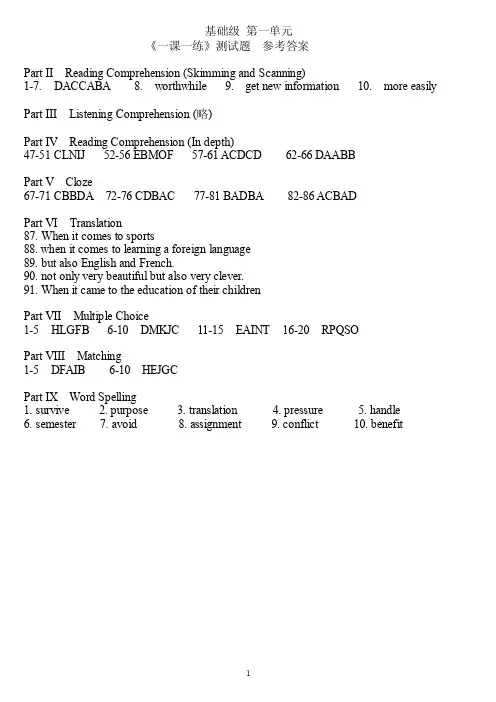
《一课一练》测试题参考答案Part II Reading Comprehension (Skimming and Scanning)1-7. DACCABA 8. worthwhile 9. get new information 10. more easily Part III Listening Comprehension (略)Part IV Reading Comprehension (In depth)47-51 CLNIJ 52-56 EBMOF 57-61 ACDCD 62-66 DAABBPart V Cloze67-71 CBBDA 72-76 CDBAC 77-81 BADBA 82-86 ACBADPart VI Translation87. When it comes to sports88.when it comes to learning a foreign language89. but also English and French.90. not only very beautiful but also very clever.91. When it came to the education of their childrenPart VII Multiple Choice1-5 HLGFB 6-10 DMKJC 11-15 EAINT 16-20 RPQSOPart VIII Matching1-5 DFAIB 6-10 HEJGCPart IX Word Spelling1. survive2. purpose3. translation4. pressure5. handle6. semester7. avoid8. assignment9. conflict 10. benefitPart II Reading Comprehension (Skimming and Scanning)1-7. BCDABCC 8. the obituary 9. A kindness returned 10. gratitude Part III Listening Comprehension (略)Part IV Reading Comprehension (In depth)47-51 NDIBG 52-56 LAFKJ 57-61 DACBC 62-66 ADBCDPart V Cloze67-71 ACBCA 72-76 DBCDA 77-81 BDBAC 82-86 BACDCPart VI Translation87. It was in middle school that88.It is his great friendship that89. let alone finish it a month ahead of time90. let alone buy a new house91. Needless to sayPart VII Matching1-5 EBHFC 6-10 GAJDIPart VIII Translation1.stand out in one’s mind2.get to know someone quite well3.a look of concern4.have very little control over somebody’s diet5.make a difference6.the rest of one’s life7.change the world for the better8.share their secrets9.It isn’t a big deal.10.t ake a message for somebodyPart II Reading Comprehension (Skimming and Scanning)1-7: CBADCAD 8. lack 9. increase your energy 10. making it Part III Listening Comprehension (略)Part IV Reading Comprehension (In depth)47-51 DJFBG 52-56 OKAMI 57-61 CCDAC 62-66 ACBDCPart V Cloze67-71 CABDC 72-76 ABACD 77-81 BABCD 82-86 BDABAPart VI Translation87. In short88.Neither do his classmates89. who was an expert in computer science90. came upon this set of elegant stamps91. Neither has her partnerPart VII Word Spelling1 beneath2 determine3 picnic4 chocolate5 exchange6 request7 title8 achieve9 opposite 10 mentalPart VIII Multiple Choice1-5 CGFDA6-10 BELJK 11-15 IHNMQ 16-20 RPOTS Part IX Translation1. a moonlit night2 set off for the city3 awake from a deep sleep4 feel unhappier than one has ever felt in all one’s life5 cheer sb up / raise (lift) sb’s spirits6 a pair of the softest slippers one could find7 until the forest echoed with his laughter8 have / own everything a man can want9 an integral part10 live mechanically and unconsciouslyPart II Reading Comprehension (Skimming and Scanning)1-7 CDABDAC 8. violence 9. doing away with 10. fulfill their promise Part III Listening Comprehension (略)Part IV Reading Comprehension (In depth)47-51 HEKCM 52-56 DAGIO 57-61 BDDCA 62-66 DCDDBPart V Cloze67-71 BCADB 72-76 ADBAC 77-81 DBCAC 82-86 CBADBPart VI Translation87. What he would probably say88.as he was reading the paper89. what you love to eat most90. As Mary was filling out the application form91. their children are dependent too much on computersPart VII Words Difference1-5 FEBAD 6-10 CHGIJPart VIII Word Form1 importance2 unfortunately3 eventually4 reacted5 success6 complaints7 illegally8 creative9 response 10 calculatedPart IX Preposition or Adverb1 on2 over3 about4 with5 to6 in7 to8 with9 to 10 from。
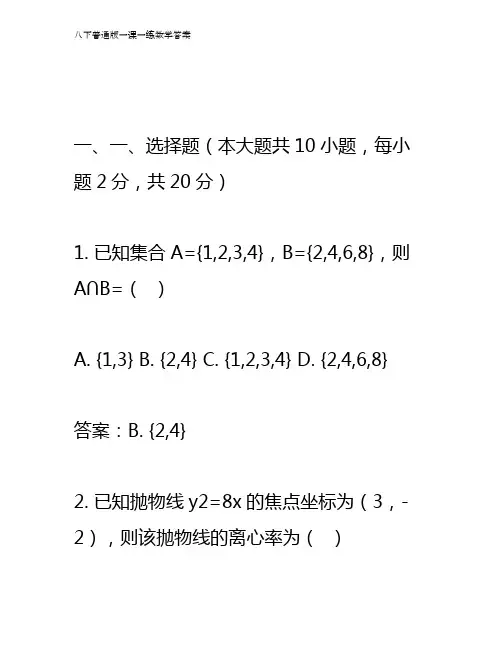
一、一、选择题(本大题共10小题,每小题2分,共20分)1. 已知集合A={1,2,3,4},B={2,4,6,8},则A∩B=()A. {1,3}B. {2,4}C. {1,2,3,4}D. {2,4,6,8}答案:B. {2,4}2. 已知抛物线y2=8x的焦点坐标为(3,-2),则该抛物线的离心率为()A. 4B. 2C. 3D. 5答案:A. 43. 已知正方形ABCD的边长为a,则该正方形的面积为()A. a2B. a3C. 4aD. 2a答案:A. a24. 已知函数f(x)=2x-1,则f(-2)的值为()A. -3B. -1C. 1D. 3答案:A. -35. 在△ABC中,若∠B=90°,AB=2,AC=3,则BC的长度为()A. 2B. 3C. 4D. 5答案:D. 56. 已知函数f(x)=2x2-3x+2,则f(2)的值为()A. -3B. 2C. 4D. 6答案:D. 67. 已知正方形ABCD的边长为2,则该正方形的面积为()A. 2B. 4C. 8D. 16答案:C. 88. 已知抛物线y2=8x的焦点坐标为(3,-2),则该抛物线的离心率为()A. 4B. 2C. 3D. 5答案:A. 49. 已知函数f(x)=2x-1,则f(-2)的值为()A. -3B. -1C. 1D. 3答案:A. -310. 在△ABC中,若∠B=90°,AB=2,AC=3,则BC的长度为()A. 2B. 3C. 4D. 5答案:D. 5二、填空题(本大题共5小题,每小题2分,共10分)11. 已知抛物线y2=4x的焦点坐标为(2,-1),则该抛物线的离心率为 2 。
12. 已知函数f(x)=2x-1,则f(-2)的值为 -3 。
13. 在△ABC中,若∠B=90°,AB=2,AC=3,则BC的长度为 5 。
14. 已知正方形ABCD的边长为a,则该正方形的面积为 a2 。
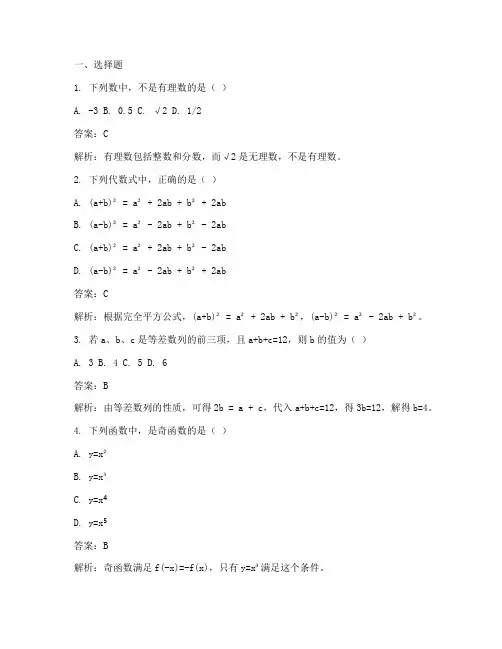
一、选择题1. 下列数中,不是有理数的是()A. -3B. 0.5C. √2D. 1/2答案:C解析:有理数包括整数和分数,而√2是无理数,不是有理数。
2. 下列代数式中,正确的是()A. (a+b)² = a² + 2ab + b² + 2abB. (a-b)² = a² - 2ab + b² - 2abC. (a+b)² = a² + 2ab + b² - 2abD. (a-b)² = a² - 2ab + b² + 2ab答案:C解析:根据完全平方公式,(a+b)² = a² + 2ab + b²,(a-b)² = a² - 2ab + b²。
3. 若a、b、c是等差数列的前三项,且a+b+c=12,则b的值为()A. 3B. 4C. 5D. 6答案:B解析:由等差数列的性质,可得2b = a + c,代入a+b+c=12,得3b=12,解得b=4。
4. 下列函数中,是奇函数的是()A. y=x²B. y=x³C. y=x⁴D. y=x⁵答案:B解析:奇函数满足f(-x)=-f(x),只有y=x³满足这个条件。
()A. a>0,b>0,c>0B. a>0,b<0,c<0C. a<0,b>0,c>0D. a<0,b<0,c<0答案:B解析:由题意得a>0,且a+b+c=0,则b<0,c<0。
二、填空题1. 若x²-2x+1=0,则x的值为______。
答案:1解析:这是一个完全平方公式,可化简为(x-1)²=0,解得x=1。
2. 若等差数列{an}的首项为2,公差为3,则第10项an的值为______。
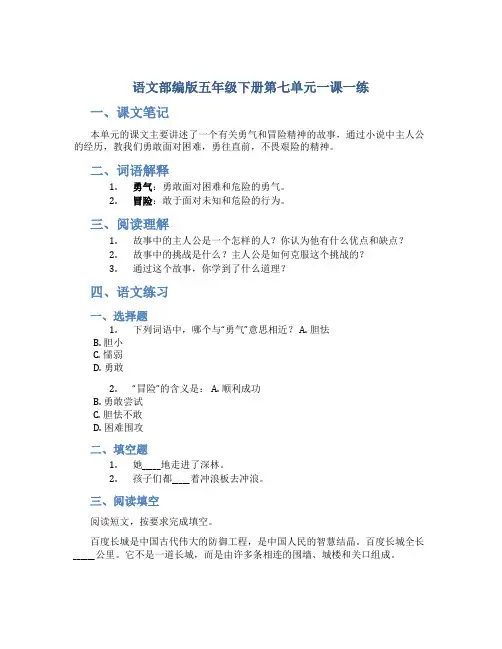
语文部编版五年级下册第七单元一课一练
一、课文笔记
本单元的课文主要讲述了一个有关勇气和冒险精神的故事,通过小说中主人公的经历,教我们勇敢面对困难,勇往直前,不畏艰险的精神。
二、词语解释
1.勇气:勇敢面对困难和危险的勇气。
2.冒险:敢于面对未知和危险的行为。
三、阅读理解
1.故事中的主人公是一个怎样的人?你认为他有什么优点和缺点?
2.故事中的挑战是什么?主人公是如何克服这个挑战的?
3.通过这个故事,你学到了什么道理?
四、语文练习
一、选择题
1.下列词语中,哪个与“勇气”意思相近? A. 胆怯
B. 胆小
C. 懦弱
D. 勇敢
2.“冒险”的含义是: A. 顺利成功
B. 勇敢尝试
C. 胆怯不敢
D. 困难围攻
二、填空题
1.她_____地走进了深林。
2.孩子们都_____着冲浪板去冲浪。
三、阅读填空
阅读短文,按要求完成填空。
百度长城是中国古代伟大的防御工程,是中国人民的智慧结晶。
百度长城全长______公里。
它不是一道长城,而是由许多条相连的围墙、城楼和关口组成。
五、写作
描述一个你曾经有过的勇敢面对困难的经历,以及你是如何克服这个困难的。
六、参考答案
选择题
1. D
2. B
填空题
1.勇敢
2.冒着
阅读填空
长城: 5000
以上是本节课的一课一练,希望同学们认真完成,加深对课文的理解和记忆。
愿大家勇敢面对困难,敢于迎接挑战!。
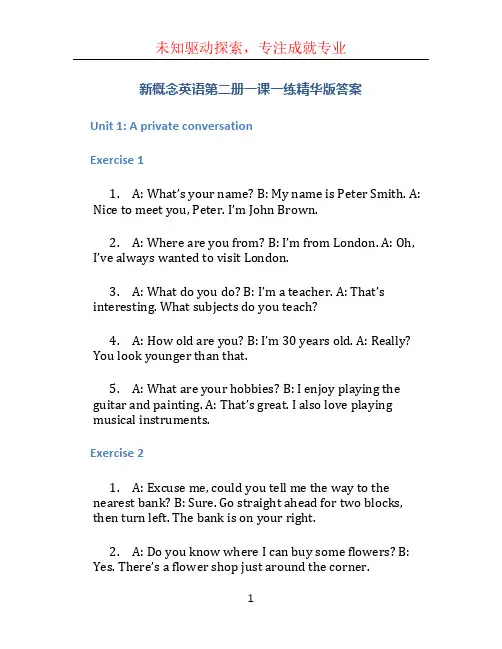
新概念英语第二册一课一练精华版答案Unit 1: A private conversationExercise 11.A: What’s your name? B: My name is Peter Smith. A: Nice to meet you, Peter. I’m John Brown.2.A: Where are you from? B: I’m from London. A: Oh, I’ve always wanted to visit London.3.A: What do you do? B: I’m a teacher. A: That’s interesting. What subjects do you teach?4.A: How old are you? B: I’m 30 years old. A: Really? You look younger than that.5.A: What are your hobbies? B: I enjoy playing the guitar and painting. A: That’s great. I also love play ing musical instruments.Exercise 21.A: Excuse me, could you tell me the way to the nearest bank? B: Sure. Go straight ahead for two blocks, then turn left. The bank is on your right.2.A: Do you know where I can buy some flowers? B: Yes. There’s a flower sho p just around the corner.3.A: Is there a post office near here? B: Yes, there’s a post office down the street. It’s on the right side.4.A: I’m looking for a good restaurant. Can you recommend one? B: Sure. There’s a great Italian restaurant on the next block.5.A: Can you help me find the nearest pharmacy? B: Of course. There’s a pharmacy across the street. You can’t miss it.Exercise 31.A: What’s your favorite color? B: My favorite color is blue. What about you?2.A: Are you a dog person or a cat person? B: I’m definitely a dog person. I love dogs.3.A: Do you prefer coffee or tea? B: I prefer tea. I don’t really like the taste of coffee.4.A: Are you a morning person or a night person? B: I’m definitely a night person. I’m more productive during the night.5.A: What’s your favorite season? B: My favorite season is autumn. I love the cool weather and beautiful foliage.Unit 2: The secretExercise 11.The secret was revealed by accident.2.He didn’t want to tell anyone the secret.3.The secret had been kept for years.4.Everyone was surprised by the secret.5.They were relieved when the secret was finally known.Exercise 21.A: Have you heard the secret? B: No, what is it? A: I’m not allowed to tell you.2.A: I promised not to tell anyone the secret. B: That’s okay. I don’t want to know.3.A: I know the secret, but I won’t tell anyone. B: Thank you. It’s important to keep it a secret.4.A: Can you keep a secret? B: Of course. You can trust me.5.A: I accidentally revealed the secret. B: That’s unfortunate. Secrets should be kept confidential.Unit 3: Please send me a cardExercise 11.A: Could you please send me a postcard from your trip? B: Sure. I’ll send you one as soon as I get there.2.A: I collect postcards from different countries. Can you send me one? B: Of course. I’ll make sure to send yo u an interesting one.3.A: I hope you’re having a great time on your vacation. B: Thank you. I’ll send you a postcard to let you know.4.A: I wish I could travel to different places and collect postcards. B: You can start by collecting postcards from local attractions.5.A: Postcards are a great way to stay connected with friends and family. B: I agree. It’s nice to receive personalized messages from loved ones.Exercise 21.A: Did you receive the postcard I sent you? B: Yes, I did. It’s beautiful. Thank you.2.A: I forgot to send you a postcard. I’m sorry. B: That’s okay. Don’t worry about it.3.A: I received a postcard from my friend who istraveling in Europe. B: That’s exciting. Postcards are a great way to share experiences.4.A: I’m going to buy some postcards to se nd to myfriends and family. B: That’s thoughtful. They willappreciate it.5.A: The postcard arrived with a lovely message frommy friend. B: It’s always nice to receive mail that isn’t a bill or advertisement.ConclusionIn this document, we have provided the answers to the exercises in Unit 1 and Unit 2 of the New Concept English Second Edition textbook. These exercises cover various topics such as introductions, asking for directions, personal preferences, keeping secrets, and sending postcards. By practicing these exercises, you can improve your English communication skills and vocabulary. Remember to review the answers and use them as a reference to check your own understanding. Good luck with your English studies!。
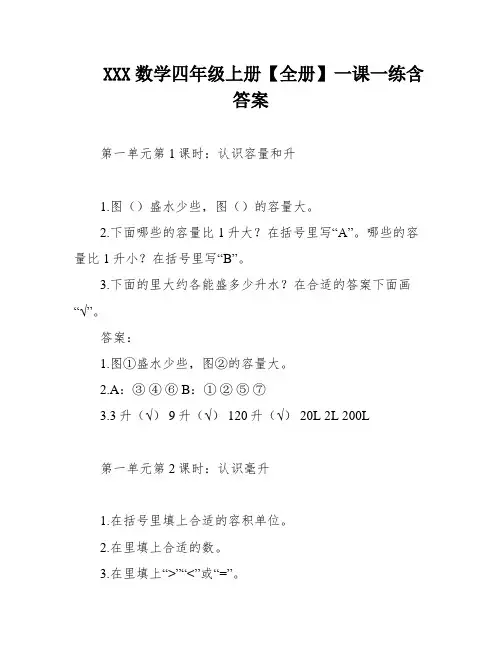
XXX数学四年级上册【全册】一课一练含答案第一单元第1课时:认识容量和升1.图()盛水少些,图()的容量大。
2.下面哪些的容量比1升大?在括号里写“A”。
哪些的容量比1升小?在括号里写“B”。
3.下面的里大约各能盛多少升水?在合适的答案下面画“√”。
答案:1.图①盛水少些,图②的容量大。
2.A:③④⑥ B:①②⑤⑦3.3升(√) 9升(√) 120升(√) 20L 2L 200L第一单元第2课时:认识毫升1.在括号里填上合适的容积单位。
2.在里填上合适的数。
3.在里填上“>”“<”或“=”。
答案:1.一个浴缸大约能盛水400升(L)一盒牛奶大约有220毫升(ml)一瓶酱油大约有2升(L)一瓶修正液大约有20毫升(ml)2.2升=2000毫升 3000毫升=3升 5升=5000毫升 9000毫升=9升3.3000毫升。
3升 1002毫升。
4升 4000毫升 < 4升 3500毫升 < 4升第一单元第3课时:练一1.一碗豆浆大约有500毫升。
一瓶果汁有1升。
2.在里填上“>”“<”或“=”。
答案:1.一碗豆浆大约有500毫升。
一瓶果汁有1升。
一个大水缸大约能盛水200升。
一个水桶大约能盛水12升。
2.1900毫升。
2升 2800毫升。
1升 16升。
3升毫升。
3升2700毫升 < 4升第二单元第1课时:除数是整十数的口算和笔算(商是一位数)1.观察算式写得数。
2.计算下面各题,并验算。
答案:1.40÷20=2 90÷30=3 12÷3=4 42÷6=740÷20=2 90÷30=3 120÷30=4 420÷60=72.420÷70=6 验算:70×6=42049÷20=2 验算:20×2+9=4965÷30=2 验算:30×2+5=65第二单元第2课时:除数是整十数的笔算(商是两位数)1.下面各式的商是几位数?连一连。

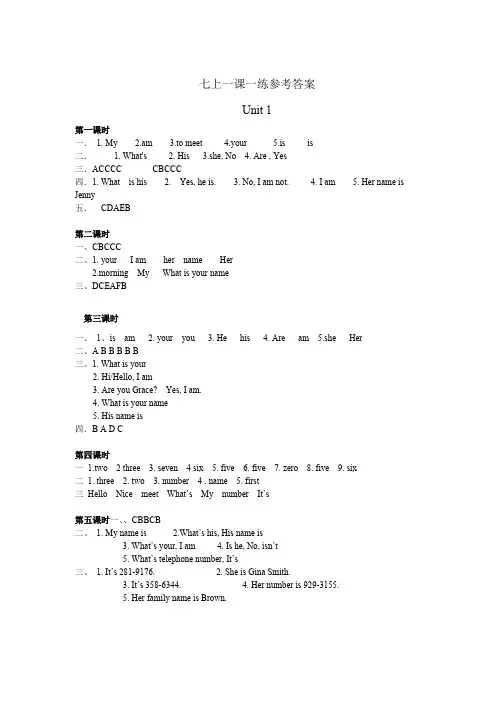
七上一课一练参考答案Unit 1第一课时一. 1. My 2.am 3.to meet 4.your 5.is is二. 1. What's 2. His 3.she, No 4. Are , Yes三.ACCCC CBCCC四.1. What is his 2. Yes, he is. 3. No, I am not. 4. I am 5. Her name is Jenny五.CDAEB第二课时一、C BCCC二、1. your I am her name Her2.morning My What is your name三、DCEAFB第三课时一、1、is am 2. your you 3. He his 4. Are am 5.she Her二、A B B B B B三、1. What is your2. Hi/Hello, I am3. Are you Grace? Yes, I am.4. What is your name5. His name is四.B A D C第四课时一 1.two 2 three 3. seven 4 six 5. five 6. five 7. zero 8. five 9. six二 1. three 2. two 3. number 4 . name 5. first三Hello Nice meet What’s My number It’s第五课时一、、CBBCB二、 1. My name is 2.What’s his, His name is3. What’s your, I am4. Is he, No, isn’t5. What’s telephone number, It’s三、 1. It’s 281-9176. 2. She is Gina Smith.3. It’s 358-6344. 4. Her number is 929-3155.5. Her family name is Brown.第六课时一、1.B 2.C 3.A 4.B 5.C二、1.meet 2.telephone number 3.His 4.first 5.China三、1.Her last name is Brown.2.What is3. My name4.Gina Jones单元检测题一、B B C A C二、B A C C B C C B B B B A B B C三、A C C B D B A C C B四、1.He is Chinese.2. He lives in China.3.Yes, it is.4.No, it isn’t.五、I、1. His 2. number 3. first 4. card 5. ageII、1. my 2. her 3. boy’s 4. first 5. you六、1. Are am 2. is 3. is 4. am 5. Is6. is7. is 8 . is is 9. are am 10. is is七、B A D C八、1.What is2. How is3. My name4. Is telephone number5.Lucy’s family name is Read.九、略Unit 2第一课时一.1---5: ACDBC二.1. brother 2. friends 3. grandfather 4. parents 5. These三.1. This is, sister 2. These 3. Those are 4. Have a good time!5. ----Who’re they? ---They are; grandparents第二课时一.1. parents 2. These 3. are 4. brothers 5. is二.1---5: BCDBC三.1.parents, are 2. These, are 3. Is, your 4. That’s, sister 5. What are 四.Yes, they, sister; They, brother/ cousin.第三课时(3a—3c)一、1—5: D, B, B, D,D二,1. These are 2. Those are 3. Those, they 4.This is 5. He三,1. are 2. these 3. those 4. photos 5. her四,1. Are, parents 2. These are, brothers 3. That is , brother4. Those are, brothers5. Is she , sister, this is, this isn’t第四课时section B(1a—1d)一,parents 2. pencils 3. clocks 4. watches 5. dictionaries 6. are7. keys 8. these 9. families 10. they 11. buses 12. them二,1---5:D, A, C,A,B三、1.keys, are, white 2.That, is 3.Is, she, sister 4.Who, is 5.What color四.aunt, uncle, cousin, who第五课时:一、1-4: D、B、A、B二、1. aunt 2. son 3. cousin 4. brother 5. daughter三、1. Here are 2. grandfather, grandmother, first photo\picture3. next picture4. Here are, photos\pictures四、1. these, they, my 2. This, Her, She 3. This, He, His 4. my, Its, I 5. my, She, her 第六课时:一1—5:B、B、D、C、D二、1---5: B、C、D、G、A三、 1. friends, here 2. his five 3. next picture 4.daughter, cousin 5. there girls四、连词成句(注意横线后的标点)1. Is that your sister?2. These are my tow cousins.3. This is a picture of my son.4. Who is that girl?5. Is that your sister Kate?单元测试一,1---5: C, A, B, D, A二,1---5: C, C, A, B, A 6---10: C, C, B, B, C 11---15: B, C, D, C, A三,1---5:B, A, B, C, A 6---10: C, C, B, A, B四,1---5:C.C.B.D.C.五.A.1、English 2. spell 3.How 4. call 5.caseB. 1. his 2. My 3. her, its 4. your 5. He, my六.1. These are 2. Is she; No, she 3. That is, sister 4. Who, they 5. isn’t 七.1. Jim and I are good friends.2. Are those your grandparents?3. Here is my family photo.4. Who are these girls?5. Tony, this is my brother.八.1. Is, friend; No, she, sister 2. are, aunts 3. her cousins 4. brother, His name 5. in, next photoUnit 3第一课时I. dictionary 2.eraser 3.pencil 4.schoolbag 5.pencil boxII.1.me 2.mine 3.boxes 4.hers 5.teachers 6.yourIII1.C 2.A 3.C 4.D 5.BIV. 6 3 1 4 2 5第二课时I.1.Excuse 2.teacher 3.yours 4.about 5.help,welcomeII.6.no,it isn’t 7.is that 8.an,araser 9.isn’t 10.what isIII.11.A 12.A 13.D 14.D 15.A第三课时一、1.D 2.C 3.A 4.C 5.B二、1.what 2.ring 3.how 4.her 5.a三、1.I’m 2.is 3.isn’t 4.thank 5.do第四课时I.1.call 2.keys 3.please 4.school 5.lostII.1.B 2.B 3.B 4.A 5.AIII.1.your 2.hers 3.call 4.keys 5.isn’t第五课时I. 1.yours 2.my,his 3.Her 4.It’s 5.youII.1.A 2.A 3C. 4.C 5.C 6.C 7.B 8.B 9.C 10.D III.1.How,spell it 2.isn’t in 3.mike is 4.Is ,this,it,isn’t 5.is,not,my单元练习一、ABCDC二、BACDC CDCBB BDCBB三、ACDCC BCBAB四、AABAB BBACA五、1. watch 2. computer 3. must 4. some 5. library6. me7. his8. rings9. mine 10. are六、1. What;is 2. How;spell; it 3.It; isn’t; his; jacket 4.Is; it; your; No; it; isn’t 5. Yes; it; is.6. It’s; not/ it; isn’t七、1.What’s;in;English 2.How;you; spell 3. Is; his; baseball 4. Is; notebook; lost; found5.a set of6. The dictionary; Alice’s八、1. I’m 2. in 3. It’s 4. How 5. W-A-T-C-H 6. Is 7. No. 8. Mary’s 9. your 10. Thank九、略Unit 4第一课时一、1. my schoolbag 2. your parents 3.our books 4. his key 5.in the drawer 6. under my bed7.under the chair 8.in your bookcase 9.on the sofa二、BBCCC三、EABDC第二课时一、CCCDA二、1. It of family 2. Are they aren’t 3. computer desk 4. schoolbag under 5.Where's It’s on第三课时一、1~5 DBCBC二、1.Where is 2. Is your 3. They are 4. is it/he/she 5. No, it isn’t.三、1. under the chair 2. in the schoolbag 3. on the table第四课时一、1. clock 2. tape player 3. model planes 4. radios 5. English book二、1. The computer is on my desk./ My computer is on the desk.2. This blue pencil is hers.3. Is his baseball under the table?4. They are not in the school library.5. I think that girl is Bob’s sister./ I think Bob’s sister is that girl.第五课时一、1. tidy 2. but 3. our 4. always 5. everywhere二、1. B 2. C 3. C 4. C 5. B 6. B 7. A三、1. is tidy, but her sister isn’t 2. books are everywhere 3. is mine, it isn’t hers第六课时一、1. desk 2. chair 3. hat 4. rooms 5. their二、1. have a model plane 2. white radio, hers 3. his notebook, It’s 4. they aren’t5. are everywhere三、I’m tidy. This is my room. My books are on my desk and in the bookcase. My pencil box is in my school bag. I have a computer. It’s on my desk, too. Where is my key? It’s not in the bookcase. It’s in my pencil box.单元测试题一、1—5 CDDAB二、1—5 CBCCA 6—10 BBCBC三、1—5 CBCA B 6—10 BCBAB四、1. everywhere 2. think 3. under 4. but 5. chairs6. are7. their8. teacher’s9. radios 10. asks五、1—5 ABACB六、1. Come on,2. Where is my schoolbag?3. Mary’s model plane is on her desk.4.Sally’s keys aren’t on her bed.5. ---Where’s my computer game? ---I don’t know.6. Ann is tidy ,but her brother Bill is not.7. I think it’s in my grandparents’ room.8. My book and my hat are on the bed.9. I have a clock.10. Is the book on your desk?七、1. Where is your 2. Are they 3. it isn’t 4. They’re baseballs5. they aren’t6. is on7. Where are八、I have a nice room. It’s tidy. This is my bed .My quilt and my hat are on it. Under it is my basketball. This is my desk. My computer and my tape player are on it .My jacket is on the chair. And my schoolbag is on the chair ,too. Oh, where are my books? They are in the bookcase. I like my room very much.Unit 5第一课时一.1. Do, do 2. Does, doesn’t 3. Do , don’t 4. Is , it isn’t二. 1. Do , have 2. They have some boxes. 3. they don’t , they do三. 1. have 2. dictionaries 3. doesn’t do 4. aren’t 5. Keys第二课时一. 1. has 2. play 3. Where’s under 4. parents’二. 1. go , bat , schoolbag , Where’s , has , jacket , get , Let’s三. 1. Has eight photos / pictures. 2. Where’s your basketball?3. Does Cindy have a ping-pong bat?4. This is our volleyball.第三课时一. 1. Does have 2. doesn’t have3. They have some boxes.二. 1. Do you have a tennis ball?2. Bob has two bats.3. I think he has a volleyball.4. My friend doesn’t have a soccer ball.第四课时(SectionB1a—1d)一、1. play her 2. sounds 3.has 4. don’t play 5. doesn’t watch studies二、1.A 2.A 3.A 4.C第五课时(SectionB 2a—2c)一、1. I don’t have a soccer ball.2. My teacher doesn’t have a ping-pong bat.3. Let us play basketball.4. Does he have a bag ?二、1.A Do 2.A That 3.C have 4.C but 5.C 去掉the第六课时一、1.my classmate 2.easy for 3.three bats 4.After class 5.think difficult二、1.C 2.E 3.D 4.B 5.A单元练习一、单词辨音(5分) 1--5 CBBBA二、单项选择(10分) 1--5 BCCDA 6--10 ACBCB三、连词成句(10分) 1. Do you have a math book? 2. My father has a small collection.3. Well, let’s play baseball.4. Does Monica have three books and a pencil case?5. Tom doesn’t have a ruler.四、根据汉语意思完成下列各句,每空一词(10分)1. sounds interesting2. Let’s go3. play sports4. tennis club5. watch TV五、按要求完成下列句子(10分)1 doesn’t have2 Do you3 have friends4 How many5 No,doesn’t六、用所给词的适当形式填空(10分)1 sounds2 Do have3 interesting4 clubs5 does6 difficult7 her8 playing9 collection 10 watches七、补充对话(10分)1 volleyball2 But3 don’t4 has5 do6 don’t7 Does8 does9 It 10 Let’s八、阅读理解(20分)1. Yes, he is.2. Yes, they are.3. Yes, he does.4. He has five baseballs.5. He watches them on TV. 6--10 ABCBA九、书面表达(15分)略Unit 6第一课时一、1 doesn’t 2 like 3 pears 4 Do 5 oranges二、1-5 B A C A C第二课时一、1 Does like 2 have 3 Gina’s 4 tomatoes 5 don’t like二、hamburgers ice-cream hamburgers tomatoes ice-cream三、1-5 B C A C B四、1、next week2、What about3、some fruit4、think about5、like eating bananas6、Sounds good第三课时一、1 don’t 2 likes doesn’t 3 like don’t 4 vegetables 5 likes bread二、1、Do you like salad?2、Yes, she does.3、He doesn’t like bread.4、He doesn’t like carrots.5、Does likeYes, she does.三、1、We like rice.2、Does your brother like eggs?No, he doesn’t.3、My milk is in my room.4、How about eating some ice-cream?第四课时一、BBDAD二、1. likes 2. Does 3. watches 4. play 5. eggs三、1.Does like 2. doesn’t play 3. Yes, does 4. What does eat 5. No, doesn’t四、 1. Her sister doesn’t like carrots.2. He likes hamburgers for lunch.3. Does Dale like apples?4. What do you like for dinner?5. They don’t like rice.五、1. carrots 2. vegetables 3. about 4. do 5. don’t’ 6. apples 7. Ice cream第五课时一、1. star 2. eat 3. habit 4. question 5. fat二、1. eating 2. to be 3. healthy 4. doesn’t like 5. do eat三、D C A C四、 1. What does 2. doesn’t want 3. No, she doesn’t五、 1. how 2. eating 3. for 4. milk 5. eat 6. oranges 7. be第六课时一、1-5BCBBC 6-9 ACCA二、1. us 2. eats 3. tomatoes, chicken 4. well 5. is三、1. doesn’t have 2. Does like 3. they do 4. are hamburgers 5. what do单元检测题一、1. ADBDC二、1. healthy 2. fruit 3. lunch 4. habits 5. boring三、1-5 DBCCD 6-10 CCCAB四、healthy 2. like 3. to eat 4. doesn’t 5. them五、1. Is this 2. What color is 3. doesn’t do 4. they don’t like tomatoes. 5. How do you六、1-5 DBDBA 6-10 BBADD七、1. eating 2. healthy 3. apples 4. Because 5. For 6. hamburgers7. carrots/chicken 8. also 9. ice-cream 10. fat八、略Unit 7第一课时:一、单项选择。
一、看拼音,写词语。
gēngxīnbiānpàolàyuètōngxiāojiānduànguāngjǐng( ) ()()()()( )ùtóngzhāngdēngjiécǎiránfàngzhǎnlǎnjiéránb( ) ()()()二、比一比,再组词。
醋()燃()饺()拌()腊()然()较()伴()宵()摊()筝()眨()销()滩()挣()泛()三、在括号里填上合适的动词,注意不能重复。
()腊八粥()新衣()庙会()毛驴()醋大蒜()年画()爆竹()灯笼四、请按一定的顺序排列下面的词语。
1.元宵节除夕重阳节清明节春节元旦中秋节2.旬年时月周日季3.自然资源木材资源森林资源生物资源第二课时一、给下列句子填上恰当的关联词。
1.()今天是元宵节,()今天的北京特别热闹。
2.()孩子们要放鞭炮,()要过春节了。
3.()除夕之夜要守岁,()除了很小的孩子,没有人睡觉。
4. 小孩子们买各种花炮燃放,()不跑到街上去淘气,在家中照样能有声有光地玩耍。
5.北京()是城市,()它也跟着农村一齐过年,()过得分外热闹。
二、阅读《北京的春节》片段,回答问题。
元宵上市,春节的又一个高潮到了。
正(zhēnɡzhènɡ)月十五,处处张灯结(jiējié)彩,整条大街像是办喜事,红火而美丽。
有名的老铺(pùpū)都要挂出几百盏灯来□各形各色□有的一律是玻璃的□有的清一色是牛角的□有的都是纱灯□有的通通彩绘全部□红楼梦□或□水浒传□(zhuànchuán)故事□这在当年,也是一种广告。
灯一悬起,任何人都可以进到铺中参观。
晚上灯中点上烛,观者就更多。
1.给文中带点的字选择正确的读音并画“√”。
2.照样子再写几个词语。
各形各色(ABAC)3.找出文中表示“全部、都”意思的词语:4.给文中缺少标点的地方补上合适的标点。
统编版《道德与法治》六年级下册一课一练含答案第一课学会尊重一课一练一.填空题1.每个人都是独一无二的个体,都拥有生而为人的(),每个人都应当得到()。
2.尊重自己包括自尊、()、()和自我接纳等方面。
3.中华人民共和国公民在法律面前一律()4.尊重自己与接受他人批评是的。
5.如果过于爱面子,输不起、说不得,就是()。
6.尊重他人是一个人()的体现。
7只有()才会获得他人的尊重。
8.一句理解、尊重的话会给别人带来()和()。
9.自信不是自满,独立不是()10.尊重他人要能够维护他人(),推己及人,让别人觉得()。
二.判断题(正确的打“√”,错误的打“×”)1.谈到尊重,我们往往关注身边默默无闻的人,忽视取得一定成就的人。
()2.中华人民共和国公民的人格尊严不受侵犯。
()3.尊重自己,意味着拒绝批评。
()4.自卑是不尊重自己的重要表现。
()5.尊重他人既是道德要求,也是法律要求()6.语言可以体现尊重。
()7.关注他人需要是尊重他人的体现。
()8.他人的尊重会让我们自傲。
()9.见到老师主动打招呼是尊重老师的表现。
三.单项选择题1..下列说法你不赞同的是()A.小明:父母值得我们尊重B.小刚:一个修鞋子的有什么了不起啊C.小红:我尊重我自己2.下面几位同学的行为属于尊重自己的是()A.六年级一班的小明在国旗下演讲穿戴非常整洁B.张丽同学为了期末取得好成绩,提前做好了小抄C.小新同学不小心把班级玻璃打破了,老师问到他的时候,他说不知道。
3.光明小学六年级三班的晓飞同学个子比较矮,一天放学的路上,从对面走来一个同学管他叫“小矬子”。
如果你是晓飞,会选择下面的哪种做法()A.把这位同学骂一顿B.要求对方道歉C.当做没听见4.下列图片中的文字与自尊有关的是()A B C5.下列语言中属于尊重他人的说法的是A.你怎么这么笨啊B.你的说法不对,我的说法才是正确的C.你身体不方便,我帮你拿东西吧四.简答题1.适度维护自己的要求是什么?2.如何做到尊重他人?参考答案:一.填空题1.尊严尊重2.自重、自爱 3 平等 4不矛盾 5 过度维护自已6文明素养 7尊重他人8.温暖鼓励9.孤立 10自尊心舒服二.判断题1.×2. √3. ×4.√5.√6.√7. √8.×9.√三.单项选择题1.B2.A3.B4. A5.C四.简答题1.(1)不过分敏感,保持情绪平稳。
阅读理解专项一、课内阅读。
(一)燕子(节选)小燕子带了它的剪刀似的尾巴,在阳光满地时,斜飞于旷亮无比的天空,叽的一声,已由这里的稻田上,飞到那边的高柳下了。
另有几只却在波光粼粼的湖面上横掠着,小燕子的翼尖或剪尾,偶尔沾了一下水面,那小圆晕便一圈一圈地荡漾开去。
1.选文主要写的是燕子(A )。
A.飞行时的样子B.停歇时的样子2.选文第2自然段中,“横掠”一词能换成“飞”字吗?下列说法正确的一项是(B)A.能。
因为“横掠”也是“飞”的意思。
B.不能。
因为“横掠”更好地表现了燕子飞行的速度快、动作灵敏。
3.选文中,燕子有哪些特点?在括号里打“√”,再用“____”在选文中画出能体现燕子这些特点的词语。
(1)身体轻盈(√) (2)动作敏捷(√)(3)喜欢唱歌() (4)飞行速度快(√)4.如果用一句话来赞美春天,你会怎么说呢?示例:春天是一个万物复苏的季节,更是一个充满希望的季节。
(二)赵州桥(节选)赵州桥非常雄伟。
桥长五十多米,有九米多宽,中间行车马,两旁走人。
这么长的桥,全部用石头砌成,下面没有桥墩,只有一个拱形的大桥洞,横跨在三十七米多宽的河面上。
大桥洞顶上的左右两边,还各有两个拱形的小桥洞。
平时,河水从大桥洞流过,发大水的时候,河水还可以从四个小桥洞流过。
这种设计,在建桥史上是一个创举,既减轻了流水对桥身的冲击力,使桥不容易被大水冲毁,又减轻了桥身的重量,节省了石料。
1.根据选文的关键句,选文的大意可以概括为:赵州桥不但雄伟壮观,而且它的设计也非常独特。
2.下列图片中,拍摄的是赵州桥的一项是(A )。
3.根据选文内容判断对错,对的打“√”,错的打“×”。
(1)赵州桥中间行车马,两旁走人。
(√)(2)赵州桥的设计很普通,在这之前很多桥梁都是这样设计的。
(×)(3)这段话介绍了赵州桥的长、宽,它的设计和这样设计的好处。
(√)4.赵州桥的设计有什么好处呢?请在选文中用“____”画出来。
1参考答案一、选择题一、选择题1、D 2。
A 3。
C 4。
C 5。
C 6。
B 7。
D 二、填空题二、填空题8、3或-2 9、}00|),{(〉且y x y x < 10、{2,3} 11、312、{0,1,2,3} 三、解答题三、解答题13、解:集合A 中的元素是点,点的横坐标,中的元素是点,点的横坐标, 纵坐标都是自然数,纵坐标都是自然数, 且满足条件x+y=6。
所以用列举法表示为:A={(0,6),(1,5),(2,4),(3,3),(4,2),(5,1),(6,0)}。
14、解:当时,方程的解集为空集042<-ac b ,当042=-ac b 时,方程的解集含一个元素;时,方程的解集含一个元素;当元素时,方程的解集含两个〉042ac b-15、解:当k=0 时,原方程变为-8x+16=0,x=2,此时集合A={2} ;当0¹k 时要使一元二次方程01682=+-x kx 有一个实根,需06464=-=D k ,即k=1。
此时方程的解为421==x x 。
集合A={4},满足题意。
,满足题意。
综上所述,使数k 的值为0或1当k=0时,集合A={2};当k=1时,集合A={4}.2参考答案一、选择题1.B ;2.D ;3.B ;4.C ;5.B ;6.C ;7.B;二、填空题8. (){}1,1-;9.R; 10. {}5,4,3,2,0; 11。
{}8,5,3,1 三、解答题12、1)a>89; 2)a=0或a=89;3)a=0或a≥8913、þýüîíì32,314、C U A={}321££=x x x 或 C U B={}2=x x A ∩B=A A ∩(C U B )=f (C U A )∩B={}3212£<=x x x 或 15、 a=-1或2≤a≤3.3参考答案一、选择题一、选择题1、A ;2、D ;3、A ;4 、A ;5、D ;6、C ;7、D ;8、A二、填空题9、{0,2,4} {0,2,3,5} ;10、{x|105,20 x x ££或}; 11、{等腰直角三角形};{等腰或直角三角形},{斜三角形},{不等边三角形},{既非等腰也非直角三角形}; 12.{1,5,9,11}三、解答题13、 解: A={0,-4},又A ÇB=B ,所以B ÍA(Ⅰ)B=f 时,=D 4(a+1)2-4(a 2-1)<0,得a<-1(Ⅱ)B={0}或B={-4}时,=D 0 得a=-1(Ⅲ)B={0,-4},îíì=--=+-014)1(22a a 解得a=1综上所述实数a=1 或a £-114、解:U={1,2,3,4,5}A={1,4}或A={2,3} CuA={2,3,5}或{1,4,5} B={3,4}(C U A )ÈB=(1,3,4,5),又 B={3,4} \C U A={1,4,5} 故A 只有等于集合{2,3} \P=-(3+4)=-7q=2×q=2×3=6 3=6 15、解:由A ÇB f ¹知方程组,,2001202y x y x y mx x 消去内有解在££îíì=+-+-+得x 2+(m-1)x=0 在0£x 2£内有解,04)1(2³--=D m 即m ³3或m £-1。
部编版五年级语文下册第一单元一课一练1 古诗三首课时练第一课时一、默写古诗《四时田园杂兴(其三十一)》,并完成后面练习。
四时田园杂兴(其三十一)昼出耘田,村庄儿女各当家。
,也傍学种瓜。
1.选择下列加点词语的正确意思。
耘田()①在田里锄草②犁地傍()①靠近②并排2.用自己的话写出这首诗后两行的意思。
二、查资料,抄写一首自己喜欢的其他田园诗。
一、写出加点词语的意思。
稚子弄冰宋代:杨万里稚子金盆脱晓冰,彩丝穿取当银钲。
敲成玉磬穿林响,忽作玻璃碎地声。
1.稚子:。
2.钲:。
3.磬(qìng):。
4.玻璃:。
二、用自己的话写出《稚子弄冰》前两句的意思。
一、把诗句补充完整,并用自己的话写出所填字词的意思。
村晚宋代:雷震草满池塘水满(),山衔落日()寒漪。
牧童()横牛背,短笛无腔()吹。
1. 。
2. 。
3. 。
4. 。
二、用自己的话写出《村晚》后两句的情景。
2祖父的园子课时练第一课时一、读拼音,写汉字。
春天到了,爷爷把我家院子后面的空地上的杂草bá()掉,用来种菜。
我用脚把那下了种的土窝一个一个地溜平,还东一脚西一脚地xiā()闹。
几天后,爷爷种的菜发芽了,我和爷爷一起chǎn()地,我往往把菜苗当做野菜gē()掉,把野菜留着。
爷爷浇菜,我拿着水piáo(),拼尽了力气,把水往天空一扬。
玩累了,我又缠着爷爷陪我去guàng()街。
二、照样子,写词语。
例:胖乎乎圆明白亮笑热三、小萧红为我们介绍院子里的景物时,我们可以看出她怎样的神态?第二课时一、给黑体字选择正确的读音。
蚌壳(bàng bàn)樱桃(yīng yīn)啃吃(kěn kěng)倭寇(wōwēi)水瓢(piáo páo)玩腻(mìnì))二、在括号里填上恰当的词。
一()花园一()李子树一()大草帽一()谷穗一()狗尾草一()倭瓜花一()果园一()白蝴蝶一()大蜻蜓三、判断下面句子使用了什么修辞手法?在相应的括号里打“√”。
第一课读懂彼此的心一、填空题:1.与父母沟通需要讲技巧,“四心”沟通法主要指的是、、、。
2、家人之间产生小矛盾是正常的,我们需要,学会以,主动将矛盾化解。
3、高要求和常督促体现着家人对我们的,独立和自主标志着我们 .二、判断题:()1. 我们要主动与家人交流沟通,让自己合理的需求和做法得到他们的理解。
()2.家人商讨事情的时候,都认为我还小,我参与了也没用。
()3.家人严格地要求我们,也是对我们的关爱方式。
()4.每天出门,爷爷总说:“路上看车,注意安全!”这唠叨中饱含着爷爷对我的爱。
()5、家人的批评和打骂不是对我们的爱。
三、单项选择题:1.爷爷突然生病了,我可以()。
A.只管自己好好上学B.抽时间多陪陪他,安慰他C.让爸爸妈妈照顾他2.和家人发生矛盾时,我()。
A.和他们吵,把事情说清楚B.他们说什么我都左耳朵进,右耳朵出C.反思自己,和家人一起商量解决的办法四、简答题:1.你从哪些地方体会到了家人对自己的爱?写一写吧。
(至少写三条)2. 请你发现自己父母的闪光点,为他们的“美”点个赞!(至少写三条)3.妈妈是一位超市的工作人员,经常需要“三班倒”,经常晚上回来都10点了,“我”可以为妈妈做些什么表达对她的关爱呢?附:第一课参考答案:一、填空: 1、留心看细心听用心讲耐心说2、理性面对积极的态度、有效的方法3、爱在逐渐长大二、判断: 1----5 对错对对错三、单项选择: 1、B 2、C四、简答: 1 、略 2、略 3、“我”可以帮妈妈热好饭菜;提前给妈妈倒杯茶等。
第二课让我们的家更美好一、填空:1、作为子女,、,练就本领,加强自身的品德修养,做到就是对家人最大的精神安慰。
2、家是我们生活的,情感的 , 精神的。
3、一个家庭承担着、、、等多方面的责任。
二、判断对错:1、妈妈说爸爸是男子汉要承担家里一切开支。
()2、当父母意见不一致时,我要站在妈妈的立场上,帮妈妈说话。
()3.我们还小还不能为家庭作贡献。
复旦大学《21世纪大学英语》自主学习第二册第一单元《一课一练》测试题Part ⅠWritingDirections: For this part, you are expected to write a short essay on the topic of A Letter of Apology. You should write at least 120 words following the outline given below:1. 表达自己对晚交作业一事的歉意2. 说明未能按时交作业的原因3. 表示自己尽快把作业补交上并表示以后将按时交作业Part ⅡReading Comprehension (Skimming and Scanning)Directions: In this part, you will have 15 minutes to go over the passage quickly and answer the questions on Answer Sheet 1. For questions 1-7, choose the best answer from the four choices marked A), B), C) and D). For questions 8-10, complete the sentences with the information given in the passage.Another IntelligenceEmotional intelligence as a theory was first brought to public attention by the book Emotional Intelligence, Why It can Matter More Than IQ by Daniel Goleman. What is emotional intelligence exactly? According to Goleman, Emotional Intelligence consists of five key elements.The first is knowing one’s own emotions.Being able to recognize that one is in an emotional state and having the ability to identify which emotion is being experienced, even if it is not a particularly comfortable feeling to admit to, e.g. jealousy (妒忌) or envy.The second is emotional awareness.Emotional awareness can then lead to m anaging one‟s emotions. This involves dealing with emotions, like jealousy, resentment(怨恨), anger, etc, that one may have difficulty accepting by, perhaps, giving oneself comfort food, or doing nice things when one is feeling low. Many people do this instinctively(本能地)by buying chocolate or treating themselves; others are able to wrap themselves in positive thoughts or …mother themselves‟. There are, of course, many people who are incapable of doing this, and so need to be taught.The third area is self-motivation (动机).Our emotions can simultaneously(同时地)empower and hinder us, so it is important to develop the ability to control them. Strategies can be learnt whereby emotions are set aside to be dealt with at a later date. For example, when dealing with the success or good fortune of others, it is better not to suppress(压抑)any …negative‟ emotion that arises. One just has to recognize it isthere. And then one just needs to be extra careful when making decisions and not allow one‟s emotions to cloud the issue, by letting them dictate how one functions with that person. The separation of logic and emotion is not easy when dealing with people.The fourth is recognizing emotions in other people.As social beings, we need to be able to deal with other people, which brings us to the next item on Goleman‟s list, namely,recognizing emotions in other people. This means, in effect, having “social radar”, i.e. learning to read the weather systems around individual or groups of people. Obviously, leading on from this is the ability to handle relationships. If we can recognize, understand and then deal with other people‟s emotions, we can function better both socially and professionally.The last one is emotions are intangible.Not being tangible(可触摸的,有形的), emotions are difficult to analyze and quantify(量化), compounded by the fact that each area in the list above, does not operate in isolation. Each of us has misread a friend‟s or a colleague‟s behavior to us and other people. The classic example is the shy person, categorized by some people as arrogant (傲慢的)and distant and by others as lively and friendly and very personable. How can two different groups make a definitive analysis of someone that is so strikingly contradictory(矛盾的)? And yet this happens on a daily basis in all our relationships — even to the point of misreading the behavior of those close to us! In the work scenario, this can cost money. And so it makes economic sense for business to be aware of it and develop strategies for employing people and dealing with their employees.All common sense you might say. Goleman himself has even suggested that emotional intelligence is just a new way of describing competence; what some people might call savior faire or savoir vivre. Part of the problem here is that society or some parts of society have forgotten that these skills ever existed and have found the need to re-invent them.But the emergence(出现)of Emotional Intelligence as a theory suggests that the family situations and other social interactions where social skills were honed(磨练)in the past are fast disappearing, so that people now sadly need to be re-skilled.1. Who first brought emotional intelligence to people‟s attention?A) Some professionals.B) John D Mayer.C) Peter Salovey.D) Daniel Goleman.2. According to the author, which emotions are people unwilling to admit to?A) Jealousy or envy.B) Fright or love.C) Delight or hope.D) Stress or joy.3. Which one of the following is the way of controlling emotions?A) To hide them completelyB) To use logical analysis.C) To recall the negative ideas.D) To ignore them for the moment and manage them later.4. It is difficult to analyze and quantify emotions because______.A) they are isolatedB) they are not flexibleC) they are intangibleD) they are misleading5. Misreading the behavior of others ______.A) is always costlyB) is a classic exampleC) occurs every dayD) is categorized by those close to us6. Goleman relates Emotional Intelligence to ______.A) efficiency B) competenceC) interaction D) common sense7. The skills of emotional intelligence need to be reinvented because_____.A) they are difficult to quantifyB) they happen in the familyC) they exist in the societyD) some people have forgotten them.8. Recognizing emotions in other people means having ____________.9. Dealing with relationships well, we can function better both ____________.10. People now need to be re-skilled because the family situations and other social interactions are______________.Part ⅢListening Comprehension (omitted)Part ⅣReading Comprehension (Reading in Depth)Section ADirections: In this section, there is a passage with ten blanks. You are required to select one word for each blank from a list of choices given in a word bank following the passage. Read the passage through carefully before making your choices. Each choice in the bank is identified by a letter. Please mark the corresponding letter for each item on Answer Sheet 2 with a single line through the centre. You may not use any of the words in the bank more than once.Questions 47 to 56 are based on the following passage.The development of Jamestown in Virginia during the second half of the seventeenth century was closely __47__ to the making and use of bricks. There were several __48__ reasons why bricks became important to the colony. Although the forests could __49__ supply sufficient (充足的) timber(木材), the __50__ of lumbering (采伐)was extremely difficult, particularly because of the lack of roads. Later, when the timber on the peninsula (半岛)had been depleted(耗尽), wood had to be brought from some distance. Building stones were also in short __51__. However,as clay was plentiful, it was inevitable that the colonists would turn to brick- making.In addition to practical reasons for using brick as the principal __52__ material, there was also an ideological reason. Brick __53__ durability and permanence. The Virginia Company of London instructed the colonists to build hospitals and new __54__ out of brick. In 1662, the Town Act of the Virginia Assembly provided for the construction of thirty-two brick buildings and prohibited the use of wood as a construction material. Had this law ever been successfully enforced, Jamestown would have been a model city. Instead, the residents failed to __55__ fully with the law. By 1699, Jamestown had __56__ into a pile of rubble with only three or fourSection BDirections: There are 2 passages in this section. Each passage is followed by some questions or unfinished statements. For each of them there are four choices marked A), B), C) and D). You should decide on the best choice and mark the corresponding letter on Answer Sheet 2 with a single line through the centre.Passage OneQuestions 57 to 61 are based on the following passage.Dam is a barrier constructed across a stream or river to impound water and raise its level. The most common reasons for building dams are to concentrate the natural fall of a river at a given site, thus making it possible to generate electricity; to direct water from rivers into canals and irrigation and water-supply systems; to increase river depths for navigational purposes; to control water flow during times of flood and drought; and to create artificial lakes for recreational use. Many dams fulfill several of these functions. In the United States the network of dams under the Tennessee Valley Authority is an outstanding example of a multipurpose dam development.The first dam of which record exists was built about 4000 BC to divert the Nile in Egypt in order to provide a site for the city of Memphis. Many ancient earth dams, including a number built by the Babylonians, were part of elaborate irrigation systems that transformed unproductive regions into fertile plains capable of supporting large populations. Because of the ravages of periodic floods, very few dams more than a century old are still standing. The construction of virtually indestructible dams of appreciable height and storage capacity became possible after the development of Portland cement concrete and the mechanization of earth-moving and materials-handling equipment.Controlling and using water by means of dams profoundly affects the economic prospects. One of the first stages in the progress of developing countries usually involves gaining the ability to use water for power generation, agriculture, and flood protection.57. What is the purpose of this passage?A) To tell the roles that dams play.B) To explain the construction of the first dam.C) To emphasize the economic effects of dams.D) To give a brief introduction to dams.58. The following are the common reasons for building dams except____.A) generating and saving electricity.B) controlling water flow in time of flood and drought.C) changing the flow of rivers.D) serving as part of the irrigation system.59. The word “transform” in the second paragraph may mean ____.A) turn B) fade C) exist D) appear60. In ancient times, the purpose of building dams was mainly to ____.A) divert river B) create artificial lakesC) irrigate fields D) protect people61. According to the author, what has a great influence on economic development of a country?A) Ancient earth dams.B) Irrigation system.C) Power generation and agriculture.D) Controlling and using water by means of dams.Passage TwoQuestions 62 to 66 are based on the following passage.“It hurts me more than you,” and “This is for your own good.” These are the statements my mother used to make years ago when I had to learn Latin, clean my room, stay home and do homework.That was before we entered the permissive period in education in which we decided it was all right not to push our children to achieve their best in school. The schools and the educators made it easy on us. They taught that it was all right to be parents who take a let-alone policy. We stopped making our children do homework. We gave calculators, turned on the television, left the teaching to the teachers and went on vacation.Now teachers, faced with children who have been developing at their own pace for the past 15 years, are realizing we‟ve made a terrible mistake. One such teacher is Sharon Klompus who says of her students “so passive” and wonders what happened. Nothing was demanded of them, she believes. Television, says Klompus, contributes to children‟s passivity. “We‟re not tr aining kids to work any more.” s ays Klompus, “We‟re talking about a generation of kids who‟ve never been hurt or hungry. They have learned somebody will always do it for them. Instead of saying …go look it up‟, you tell them the answer. It takes greater energy to say no to a kid.”Yes, it does. It takes energy and it takes work. It‟s time for parents to end their vacation and come back to work. It‟s time to take the car away, to turn the TV off, to tell them it hurts you more than them bu t it‟s for their own good. It‟s time to start telling them no again.62. In the permissive period, we think ________.A) we pushed the kids a lot.B) i t‟s reasonable to help kids.C) i t‟s sensible to avoid pushing kids too hard.D) i t‟s good to ignore educ ation completely.63. What‟s the meaning of “permissive period in education” in paragraph 2?A) It means children can do what they want to.B) It means when everything can be taught at school.C) It means when children are pessimistic about education.D) It means when children are allowed to quit education.64. What does the author mean by saying “It takes greater energy to say no to a kid”?A) We always agree with the kids.B) It‟s easy to give the right answer.C) It‟s difficult for parents to refuse to help kids.D) It needs more energy to help kids.65. Why are children becoming more passive in study?A) Because they watch TV too frequently.B) Because they have no interest in it.C) Because they have nothing else to do.D) Because parents are rather strict with them.66. What can we infer from the passage?A) Parents should interact with their children.B) Kids should have more activities at school.C) Parents should be stricter with our children.D) Parents should always behave themselves.Part ⅤClozeDirections: There are 20 blanks in the following passage. For each blank there are four choices marked A), B), C), and D) on the right side of the paper. You should choose the ONE that best fits into the passage. Then mark the corresponding letter on Answer Sheet 2 with a single line through the centre.Part VI TranslationDirections: Complete the sentences by translating into English the Chinese given in brackets. Please write your translation on Answer Sheet 2.87.If he had known this would happen, ________________(他也许会以不同方式行事).88. ____________(他刚到家)when it started raining.89.A minute ago the old lady ____________(撕开信封)with great excitement.90. My washing machine broke down this morning. ________(我打算明天把它送去修理).91.The report said that the sample water had too much lead in it, __________(可能对我们的健康有害).Part VII Multiple ChoicesDirections: Complete the following sentences by choosing the proper words.1. I‟ve always envied painters and poets — I have no _____ abilities at all.2. He‟s struggling to _____ his fear of flying, but he still panics sometimes when he has to board a plane.3. She held her newborn baby with _____ tenderness.4. The whole nation was _____ into profound grief when Princess Diana died in an accident.5. The volunteers‟ _____ is to work with the police to reduce crime on the streets of New York.6. The city is planning a public _____ to awaken people to the problem of noise pollution.7. He was knocked unconscious by a stone, and after I _____ him, he didn‟t recognize me.8. Once their books are open, A students don‟t let anything _____ them from their studies.9. Amanda wasn‟t feeling well that d ay but she performed in the play with her _____ ease.10. When you feel overwhelmed by the complications of life in the big city, it‟s good to _____ to the countryside for a few days.11. In times of war, people usually buy and store more food as a _____ against shortage.12. The closing of the cigarette factory had _____ effects on the town‟s economy.Part VIII MatchingPart IX Word SpellingDirections: Complete the following sentences with the words you have learned in Text A . The first letter of each word has already been given.1. Do you know anything about the presidential election c________(竞选运动) of Obama?2. He went to Japan on a special m_______(使命).3. Don‟t say anything about what we‟re discussing to anyone; it‟s p_______(私人的).4. The noise in the street d_______(分散注意力)me from my reading.5. I‟m not a_______ (习惯的)to getting up so early to do morning exercise.6. We should take p_______ (预防措施)against fire.7. The whole nation were p_______(使陷入)into deep sorrow at this news.8. They had to o_______(克服)all the difficulties in their studies.9. His encouraging words r_______(使恢复精力)my drooping spirits.10. Our country is a_______(大量的)in natural resources.复旦大学《21世纪大学英语》自主学习第二册第一单元《一课一练》测试题参考答案Part I WritingA Letter of ApologyDear Mr. Wang,I am writing to apologize for my late assignment. The assignment which you assigned us last Monday was due this Friday,but to my regret,I haven‟t even started it yet. I feel really sorry for not handing in the assignment on time and for the inconvenience it would bring to you.I caught a serious cold last week and the doctor asked me to stay in bed for a week since I was very weak and the weather was very cold these days. Therefore, I couldn‟t go to the library to get the necessary referential informati on which was needed for my assignment. As a result, I have not started doing it yet and could not hand it in on time.Fortunately I have finally fully recovered. I will finish the assignment as soon as I can and try my best to hand in homework on time in the future.Sincerely yours,Li MingPart II Reading Comprehension (skimming and Scanning)1-7 DADCCBD8. “social radar”9. socially and professionally10. fast disappearingPart III Listening Comprehension(omitted)Part IV Reading Comprehension (Reading in Depth)47-51 GDNBK; 52-56 LCFIO57- 61 DCACD; 62-66 CACACPart V Cloze67-71 BCACB 72-76 DDCAD77-81 AACAB 82-86 BDDBCPart VI Translation87. he would have acted differently或he would have acted in a different way88. Hardly had he arrived home或He had hardly arrived home89. tore the envelope open90. I‟ll have it fixed tomorrow或I‟m going to have it fixed tomorrow91. which might damage our health或which might do harm to our health Part VII Multiple Choices1--6 DHEFLC; 7-12 IKAJBGPart VIII Matching1--5 BCDEAPart IX Word Spelling1. campaign2. mission3. private4. distracted5. accustomed6. precautions7. plunged8. overcome9. revived 10. abundant。